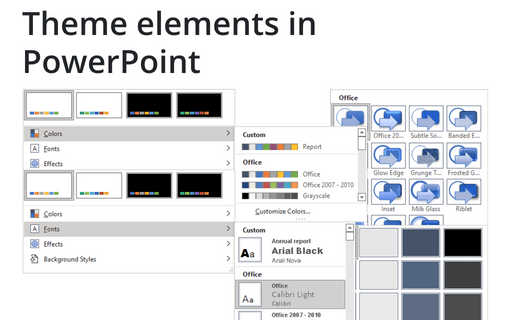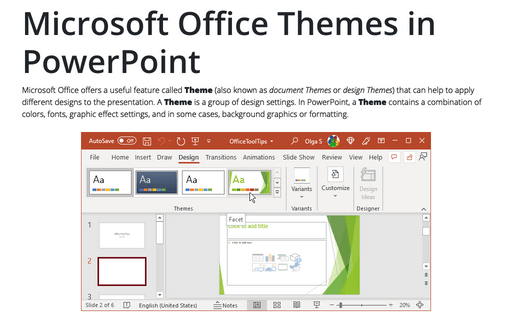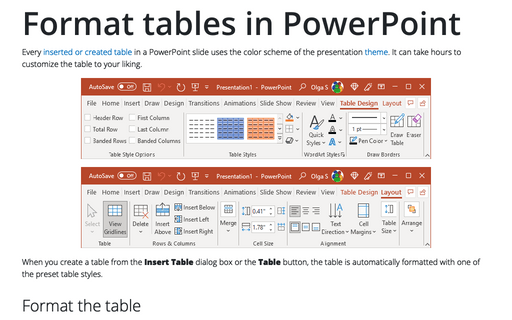Theme elements in PowerPoint
Theme Colors
Each Theme has a predefined Colors set that can be changed separately from the Theme. Each color in a Colors set has a specific role in formatting styled elements: four text and background colors, six accent colors (associated with the chart's colors by default), and two hyperlink colors.
The Theme Colors are associated with a Color palette (see more about fill and outline options):

Apply a Colors set
To apply any of the predefined Colors sets (in the ScreenTip is Theme Colors), follow the next steps:
1. On the Design tab, in the Variants group, click the More button:

From the Variants list, choose the Colors list, then choose a Colors set:
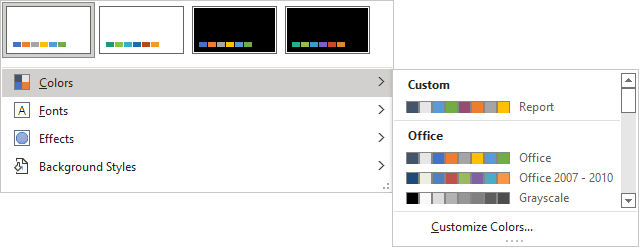
The Colors list displays:
- Custom sets in the Custom area, if available (i.e., if *.xml files are found in the Theme Colors folder - see how to create a custom Colors set for more details),
- All the predefined Colors sets in the Office area.
See more about Variants.
2. Point to a Theme Colors and observe the preview of the presentation.
3. Do one of the following:
- Click the desired Colors set to apply it.
This command applies the chosen Colors set to:
- All slides in the presentation if it uses only one theme and no slides are selected:

- Slides with the theme of the current slide (slides 2-4 in the example below) if the presentation uses more than one theme and no slides are selected:

- Selected slides.
- All slides in the presentation if it uses only one theme and no slides are selected:
- Right-click on the chosen Colors set and select one of the suggested options from the popup menu:
- Apply to Matching Slides,
- Apply to All Slides,
- Apply to Selected Slides:

Note: The first Colors set in the Office area is the colors in the current theme.
Customize a Colors set
To create a new Colors set, on the Design tab, in the Variants group, click the More button, then in the Variants list, click the Customize Colors... option at the bottom of the Colors list:
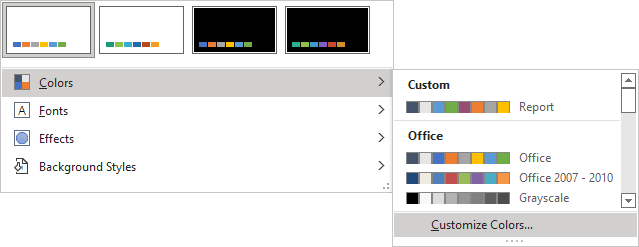
In the Create New Theme Colors dialog box:

- Apply color to every of the 12 color placeholders (see how to apply a solid color) you want to change,
- Type a name for the new theme colors in the Name field,
- Click the OK button to save a created Theme Colors.
See more about how to change the default colors for the chart series.
A custom Theme Colors is saved as a *.xml file in the Theme Colors folder and is automatically added to the top of the Colors gallery in the Custom area.
The location of the Theme Colors folder may vary, but it is usually located here:
C:\Users\
Note: If you save a new custom Colors set with the same name as an existing *.xml file in the Theme Colors folder, PowerPoint automatically adds a number 1 at the end of the file name. So, you need to delete the old Colors set and rename the new one by renaming the corresponding *.xml file in the Theme Colors folder.
Modify a custom Colors set
To modify a custom Colors set, right-click on it in the Colors list, then choose Edit... in the popup menu:

Share a custom Colors set
A custom Colors set is only available to the current Windows user logged in to the PC, tablet, etc. If you want to share it with other users or locations, you can save and copy it:
1. In the Theme Colors folder (see where you can find the Theme Colors folder), find the *.xml file with the custom name you want to share.
2. Copy this *.xml file to another location you need or send it.
Note: A custom Colors set should be placed in the Theme Colors folder to appear in the Colors list. All *.xml files from that folder automatically appear in the Custom area of the Colors list.
Delete a custom Colors set
To delete a custom Colors set, do one of the following:
- In Windows Explorer, open the Theme Colors folder (see where you can find the Theme Colors folder), then delete the *.xml file with the name of the custom Colors set you want to delete.
- On the Page Layout tab, in the Themes group, click the Colors button.
In the Custom area of the Colors list, right-click the custom Colors set, then choose Delete... in the popup menu:

Fonts
Each Theme has a predefined Fonts set that can be changed separately from the Theme. Each font in a Fonts set contains two default fonts, one for headings and one for the body of the document:
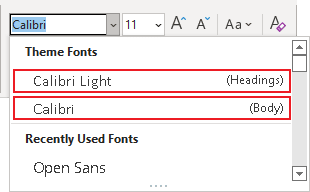
Apply a Fonts set
To apply any of the predefined Fonts sets (in the ScreenTip is Theme Fonts), follow the next steps:
1. On the Design tab, in the Variants group, click the More button:

From the Variants list, choose Fonts, then choose one set:

The Fonts list displays:
- Custom sets in the Custom area - all available *.xml files in the Theme Fonts folder - see how to create a custom Fonts set for more details,
- All the predefined Fonts sets in the Office area.
2. Point to Theme Fonts and observe the preview on the document.
3. Do one of the following:
- Click the desired Fonts set to apply it.
This command applies the chosen Fonts set to:
- All slides in the presentation if it uses only one theme:

- Slides with the theme of the current slide (slides 2-4 in the example below) if the presentation uses more than one theme:

- All slides in the presentation if it uses only one theme:
- Right-click on the chosen Fonts set and select one of the suggested options from the popup menu:
- Apply to Matching Slides,
- Apply to All Slides:

Customize a Fonts set
To create a new Fonts set, click the Customize Fonts... option at the bottom of the Fonts list. In the Create New Theme Fonts dialog box:
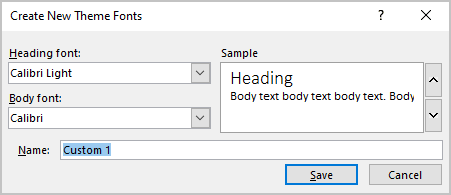
- Choose fonts you prefer from the Heading font and Body font lists.
In the Sample area, see how your choice will look like.
- In the Name field, type an appropriate name for the new Fonts set.
- Click the Save button.
A custom Theme Fonts set is saved as a *.xml file in the Theme Fonts folder and automatically added to the top of the Fonts list in the Custom area.
The location of the Theme Fonts folder may vary, but it is usually located here:
C:\Users\
Note: If you save a new custom Fonts set with the same name as an existing *.xml file in the Theme Fonts folder, PowerPoint automatically adds a number 1 at the end of the file name. So, you need to delete the old Fonts set and rename the new one by renaming the corresponding *.xml file in the Theme Fonts folder.
Modify a custom Fonts set
To modify a custom Fonts set, right-click on it in the Fonts list, then choose Edit... in the popup menu:
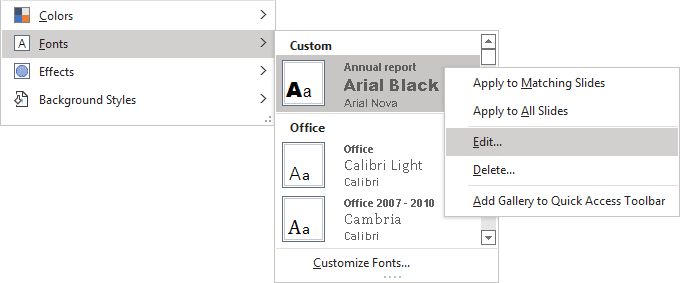
Share a custom Fonts set
A custom Fonts set is only available to the current Windows user logged in to the PC, tablet, etc. If you want to share it with other users or locations, you can save and copy it:
1. In the Theme Fonts folder (see where you can find the Theme Fonts folder), find the *.xml file with the name you want to share.
2. Copy this *.xml file to another location you need or send it.
Note: A custom Fonts set should be placed in the Theme Fonts folder. All *.xml files from that folder automatically appear in the Custom area of the Fonts list.
Delete a custom Fonts set
To delete a custom Fonts set, do one of the following:
- In Windows Explorer, open the Theme Fonts folder (see where you can find the Theme Fonts folder), then delete the *.xml file with the name of the custom Fonts set you want to delete.
- On the Page Layout tab, in the Themes group, click the Fonts button.
In the Custom area of the Fonts list, right-click the custom Fonts set, then choose Delete... in the popup menu:
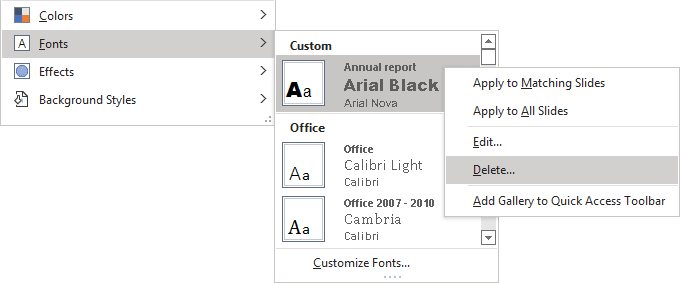
Background style
A background is a color, texture, pattern, or image that fills an entire slide. Visually, the filling can occupy only part of the slide, but in fact, it is the filling of the entire slide; there cannot be a partial background.
PowerPoint allows you to overlay background graphics on top of the background. A background graphic is an object or several objects placed on the background of a slide that complements the background.
For example, the predefined Facet theme contains:
- A pure white background.
Note: The background can be changed using the Format Background command.
- A green background graphic overlaid on the background consists of several different shapes painted in different shades of green and gray straight lines:
Each of these objects can be individually edited, moved, or even removed in the Slide Master view.

Note: The background graphics included in the predefined themes in PowerPoint are unique to those themes and not available as separate graphics outside of them.
Apply a Background Style
Background styles are sets of background format and background graphics. Various background styles are available depending on the applied theme. These background styles use the Theme Colors, so the colors change depending on the Colors set applied.
To apply a Background Style, follow the next steps:
1. On the Design tab, in the Variants group, click the More button:

From the Variants list, choose Background Styles:

2. Point to Background Style and observe the preview on the document.
3. Do one of the following:
- Click the desired Background Style to apply it.
- Right-click on the chosen Background Style and select one of the suggested options from the popup menu:
- Apply to Matching Slides,
- Apply to All Slides,
- Apply to Selected Slides:
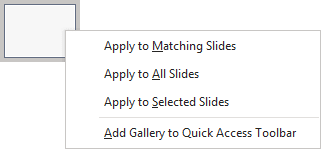
Customize a Background
PowerPoint offers the possibility to customize Background and Background graphics in different places. You can add, customize, modify, or remove the background graphics in the Master Slide view.
To apply a custom Background fill, do the following:
1. Select a slide or slides for which you want to apply a custom background style. If you want to apply a new Background fill, you don't need to select all slides - use the Apply to All button (see below).
2. Click the Format Background... option at the bottom of the Background Styles list.
3. On the Format Background pane, choose the filling style you prefer:
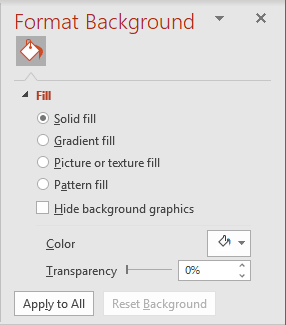
See Fill and outline options in Microsoft for more details.
PowerPoint applies customization to the selected slides. You can:
- Select the Hide Background graphics checkbox to hide the background graphics for the selected slides,
- Click the Apply to All button to apply the customization to all slides in the presentation,
- Click the Reset Background button to revert the customization.
Modify a Background
To modify a Background for any slide, group of slides, or all slides in the presentation, do the following:
1. Select a slide or several slides.
2. Do one of the following:
- Right-click on the selection and choose Format Background... in the popup menu:

- On the Design tab, in the Variants group, click the More button, then from the Background Styles list, choose Format Background...:
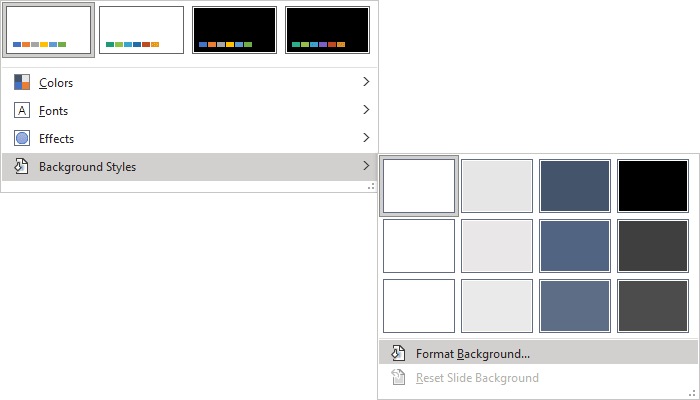
PowerPoint opens the Format Background pane, where you can select the filling options.
Delete a custom Background Style
To delete a custom Background Style, do one of the following:
- On the Design tab, in the Variants group, click the More button, then from the Background Styles list, choose Reset Slide Background:

- Open the Format Background pane, then click the Reset Background button at the bottom of the pane.
Effects
Themes have a predefined Effects set that controls graphic objects such as charts and SmartArt. Theme Effects are most evident when you use colorful 3-D graphics. Changing the effects changes the appearance, such as drop shadows, beveled edges, and textures.
You can choose different Effects sets, but you can't customize them or create a new one.
Apply an Effect
To apply any of the predefined Effects (in the ScreenTip is Theme Effects), follow the next steps:
1. On the Design tab, in the Variants group, click the More button:

From the Variants list, choose Effects, then choose one set:
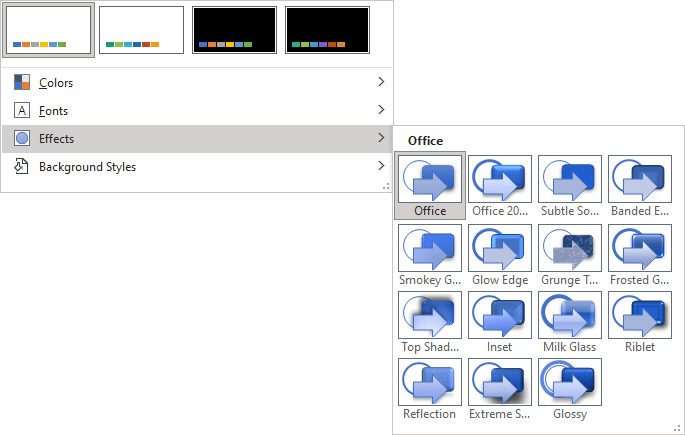
2. Point to Theme Effects and observe the preview on the slide.
3. Do one of the following:
- Click the desired Effects set to apply it.
- Right-click on the chosen Effects set and select one of the suggested options from the popup menu:
- Apply to Matching Slides,
- Apply to All Slides:

